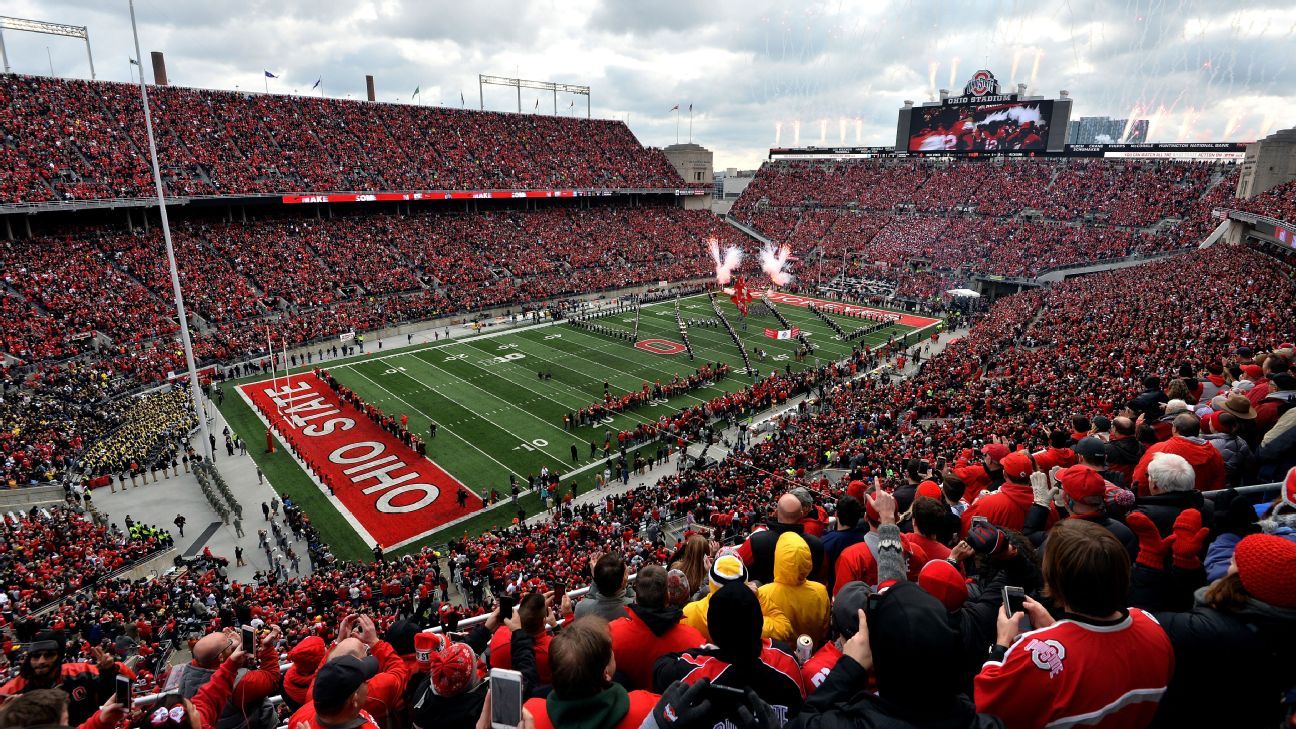The Big Ten athletic directors and presidents on Thursday decided to move all fall sports to a conference-only model, a decision that will have a snowball effect on the rest of college football.
It will affect 36 scheduled opponents, including 28 from the FBS and eight from the FCS. Six FBS schools — Ball State, Bowling Green, BYU, Central Michigan, UConn and Northern Illinois — were scheduled to play two Big Ten opponents this season.
The Big Ten will lose marquee nonconference matchups, including Michigan’s road game at Washington on Sept. 5, Ohio State’s trip to Oregon on Sept. 12, Michigan State’s home game against Miami on Sept. 26, and Wisconsin’s contest against Notre Dame at Lambeau Field on Oct. 3.
While so much about the 2020 college football season remains unknown, here are the biggest questions raised by the Big Ten’s move.
Are other conferences going to follow suit?
Probably, though the SEC would likely show the most resistance to it because of enormous pressure from within the conference to play as many games as possible. If the other four major conferences are in lockstep, though, it will likely force SEC commissioner Greg Sankey to join them.
As for the Pac-12, it just lost one of its biggest nonconference games. Remember, Ohio State was supposed to play Oregon in one of the most highly anticipated nonconference games of the season — forcing Buckeyes athletic director Gene Smith to now cancel a game with his friend and former fellow CFP selection committee member Rob Mullens. A source tells ESPN the Pac-12 presidents are meeting on Friday.
A source in the Big 12 told ESPN recently that the conference athletic directors were unanimously in favor of playing a full schedule, but commissioner Bob Bowlsby may be able to convince them otherwise, especially on the heels of the Big Ten’s news. Sources say the ACC would be amenable to a conference-only schedule.
Every conference at the FBS level has been considering a conference-only model since this past March, so it’s not a new concept to any of them. If they want to follow the Big Ten’s lead, any of them should be able to do it quickly, and it would make sense to decide sooner than later so that all of the opponents who have been cut from the schedule could also make their own plans.
What does conference-only play mean for Notre Dame?
For the independent outlier, this is a predicament, but there is a solution. First, losing the Wisconsin game is significant, but the Irish could overcome that alone. The problem comes if the Pac-12 does follow suit, because then Notre Dame would lose two additional games in Stanford and USC. The most likely and expected scenario there would be for Notre Dame athletic director Jack Swarbrick and ACC commissioner John Swofford to extend their partnership and have the Irish fill the rest of their schedule with ACC games. Notre Dame is playing six ACC opponents already.
What about the other FBS independents?
If the other Power 5 leagues elect to do what the Big Ten is doing, BYU might be looking to fill half of its 12-game regular season schedule. The Cougars are scheduled to play Utah, Michigan State, Arizona State, Minnesota, Missouri and Stanford. Army has already lost a game against Ivy League foe Princeton, and the Black Knights are also slated to face Oklahoma at home. UConn is scheduled to play five Power 5 opponents, Liberty is scheduled to play three ACC teams (Virginia Tech, Syracuse and NC State), New Mexico State has road games scheduled against UCLA and Florida, and UMass is slated to play at Auburn.
Does the Big Ten still expect to play a full conference season?
Big Ten officials are still considering the possibility of moving its division games to the front of the schedule, in case the season is interrupted by the coronavirus. That way, it might still be able to determine a championship through division winning percentage in spite of an incomplete season.
Ohio State athletic director Gene Smith is still hoping for a full, 10-game conference schedule.
“I’m hopeful that that’s where we end up next week in locking that down,” he said. “We’ve talked about that, and that’s our preference.”
“We have not delved deep into those details yet,” Smith added. “I anticipate next week we’ll get into the details of how our schedules will work.”
Smith also said if they’re able to play in September, but something happens later in the month or in October, “we can hit the pause button and provide a window of opportunity for our student-athletes not to be put at risk. We can move games. … There’s a flexibility, I can’t say that enough, that’s significant.”
Get used to it. If there is going to be a season this year, every option needs to be on the table.
What does this mean for the College Football Playoff and bowl games?
CFP executive director Bill Hancock has told ESPN that the playoff will be ready for “whatever comes down.” As for the overall bowl system, the immediate impact is unknown. It depends in part what the other conferences decide. If the other Power 5 conferences follow the Big Ten’s lead and play only conference games, overall league depth will be the most significant factor in the eyes of the CFP selection committee. Teams from top-heavy leagues and divisions might have more trouble since they won’t have the opportunity to secure big nonconference wins, especially if they stumble in conference play.


